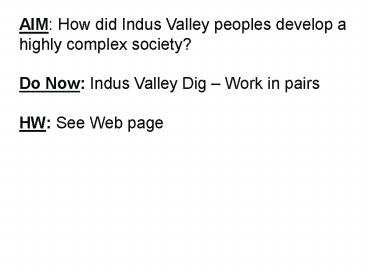Chapter 3: Ancient Indian Civilizations - PowerPoint PPT Presentation
1 / 18
Title:
Chapter 3: Ancient Indian Civilizations
Description:
AIM: How did Indus Valley peoples develop a highly complex society? Do Now: Indus Valley Dig Work in pairs HW: See Web page Chapter 3: Ancient Indian ... – PowerPoint PPT presentation
Number of Views:134
Avg rating:3.0/5.0
Title: Chapter 3: Ancient Indian Civilizations
1
AIM How did Indus Valley peoples develop a
highly complex society? Do Now Indus Valley
Dig Work in pairs HW See Web page
2
Chapter 3 Ancient Indian Civilizations
Harappan Excavations
3
I. Geography and Climate
- Indian civilization developed in the Indus River
valley about 4,500 years ago
4
II. Early Civilizations in the Indus River Valley
- 2500 BC to 1500 BC the Harappan Civilization
developed in the Indus River valley
An artistic conception of ancient Lothal
5
II. Early Civilizations in the Indus River Valley
- The named derives from one of the two discovered
cities - Harappa and Mohenjo Daro ("Mound of the
Dead)
Early settlements date to 7000 BC
6
II. Early Civilizations in the Indus River Valley
- Both cities were planned with wide streets, water
systems, public baths, and brick sewers
Ruins of Harappa
7
This map shows the layout of Mohenjo-Daro, one of
the principal cities of the Indus Valley
civilization. The larger eastern area contained
the residential and commercial sections of the
city, which were laid out in a grid of large
rectangular blocks. Rising more than twenty feet
to the west stood the citadel, built on a mound
of mud brick and rubble. Fortified by a brick
wall and towers, the citadel contained the citys
shrine, assembly hall, baths, and granary.
8
The Great Bath was entered using two wide
staircases, one from the north and one from the
south. The floor of the tank is watertight due to
finely fitted bricks laid on edge with gypsum
plaster.
9
II. Early Civilizations in the Indus River Valley
- Each city had a strong central fortress, or
citadel, on a brick platform
Excavated ruins of Mohenjo-daro
10
II. Early Civilizations in the Indus River Valley
- Storehouses for grain indicate careful planning
and a strong central government
Harappa granary
11
II. Early Civilizations in the Indus River Valley
- Harappan farmers grew crops in irrigated fields
and raised livestock
Ceramic sculpture of a small cart with vases and
tools pulled by oxen, from Mohenjo-daro
12
II. Early Civilizations in the Indus River Valley
- As early as 2300 B.C., the Harappans traded with
the people of the Tigris-Euphrates valley
This seal, found in Mesopotamia, indicates a
product was made in Harappa, indicating trade
took place between the two regions
13
Indus Valley Seals
14
II. Early Civilizations in the Indus River Valley
- A written language was developed but it has not
been deciphered or connected to other languages
15
II. Early Civilizations in the Indus River Valley
- No temples or religious writings have been found,
just animal images and some evidence of a mother
goddess of fertility
16
Terracotta Figurines
17
II. Early Civilizations in the Indus River Valley
- The Harappan civilization disappeared - theories
include changes in the Indus River, earthquakes,
or invasion
18
II. Early Civilizations in the Indus River Valley
Harappan Excavations A Walk through
Mohenjo-Daro A Walk around Harappa































